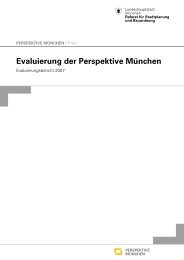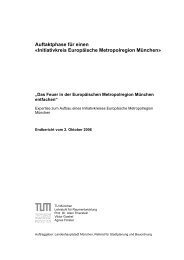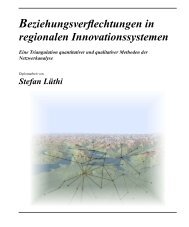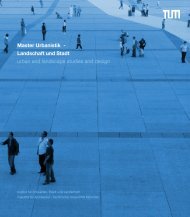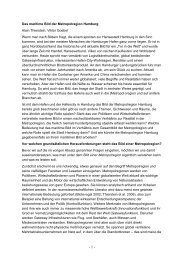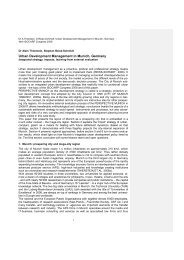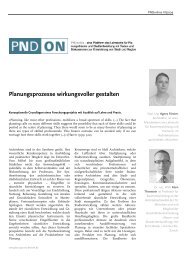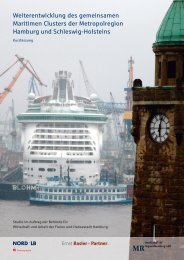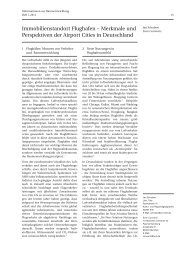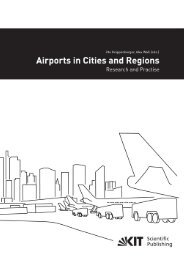0.6-1-Cover and Table of Contents-pp 0-05.indd - Raumentwicklung ...
0.6-1-Cover and Table of Contents-pp 0-05.indd - Raumentwicklung ...
0.6-1-Cover and Table of Contents-pp 0-05.indd - Raumentwicklung ...
You also want an ePaper? Increase the reach of your titles
YUMPU automatically turns print PDFs into web optimized ePapers that Google loves.
MAHMOUD REZA SAGHAFI, JILL FRANZ, AND PHILIP CROWTHER<br />
Perceptions <strong>of</strong> Physical versus Virtual Design Studio Education<br />
describes the dominant features <strong>of</strong> each element<br />
introduced in the theoretical framework:<br />
1. Culture<br />
Culture can result in different social environments;<br />
here focus on collaboration, interaction, <strong>and</strong><br />
communication. For the participants, greater<br />
emphasis is given to the physical design studio<br />
for cultural aspects like communication <strong>and</strong><br />
interaction, but that extent depends on other<br />
factors such as the nature <strong>of</strong> the curriculum <strong>and</strong><br />
the teaching a<strong>pp</strong>roaches that in some cases can<br />
inhibit communication with tutors <strong>and</strong> classmates.<br />
Even if on campus, outside work is also seen to<br />
deter students from interacting <strong>and</strong> minimising<br />
the extent to which they socialise together. There<br />
was also significance in students’ preference with<br />
some preferring to work alone <strong>and</strong> others in the<br />
company <strong>of</strong> their peers.<br />
2. Community<br />
Although all people in a school form a<br />
community other sub-communities exist based<br />
on needs <strong>and</strong> preferences. Students, teachers,<br />
<strong>and</strong> administrators for example have their own<br />
communities. Forming communities is facilitated<br />
by being able to hear <strong>and</strong> see others through<br />
audio <strong>and</strong> video. In this regard PDS enables more<br />
face-to-face integration with classmates <strong>and</strong><br />
tutors than VDS <strong>and</strong> for many students provides<br />
a more comfortable, motivating environment. In<br />
addition, a VDS can lead to alienation, confusion,<br />
<strong>and</strong> loss <strong>of</strong> identity.<br />
For the students in the study, their sense <strong>of</strong><br />
belonging as a student <strong>and</strong> being a part <strong>of</strong><br />
learning community were found to be influenced<br />
by their study commitments, work activities,<br />
<strong>and</strong> private life responsibilities. As stated by one<br />
student:<br />
[...] there is never enough time with teachers. Peers<br />
work very hard outside <strong>of</strong> uni so there is also little<br />
contact on campus. If more time was dedicated<br />
to studio <strong>and</strong> less to the culture <strong>of</strong> outside work<br />
that’d be great.<br />
While enhancing flexibility the virtual design studio<br />
may also lead to less face-to-face contact, a<br />
situation already exacerbated by work dem<strong>and</strong>s<br />
experienced by students attending studio classes<br />
on campus. For many students <strong>and</strong> tutors, PDS<br />
was understood to produce more motivation to<br />
participate in the learning activities due to the<br />
face-to-face communication <strong>and</strong> interaction.<br />
As a student described; “Being in the studio<br />
room with 20 students <strong>and</strong> a tutor is really helpful,<br />
enjoyable, <strong>and</strong> motivated”. For others, such an<br />
environment can be distracting <strong>and</strong> physically<br />
uncomfortable if not designed well.<br />
3. Spaces<br />
Learning space refers to the setting where the<br />
learning activities occurred, including both<br />
physical <strong>and</strong> virtual environments. To some<br />
extent, the study found that preferences for being<br />
<strong>of</strong>f or on campus depended on the quality <strong>of</strong> the<br />
relationships between the students as well as the<br />
quality <strong>of</strong> the physical learning environment. It also<br />
depends on levels <strong>of</strong> comfort <strong>and</strong> the physical<br />
design studio was not necessarily perceived as<br />
being better than the virtual design studio.<br />
A setting could be too boring, uncomfortable,<br />
or too formal to be su<strong>pp</strong>ortive <strong>of</strong> expression<br />
<strong>and</strong> creativity. In response to a question asking<br />
‘When you are designing, how conscious are you<br />
<strong>of</strong> the world (your environment, other people,<br />
etc) in which you are physically located?’, one<br />
<strong>of</strong> the students wrote; “Very, if in a boring or<br />
uncomfortable environment I cannot work”.<br />
Archnet-IJAR, International Journal <strong>of</strong> Architectural Research - Volume 6 - Issue 1 - March 2012<br />
11



